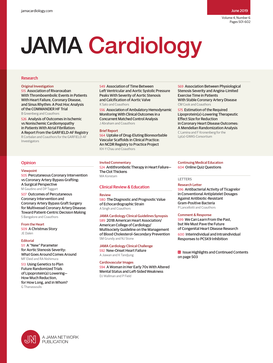短期暴露于低温和高温与瑞典心力衰竭患者的死亡率
IF 14.1
1区 医学
Q1 CARDIAC & CARDIOVASCULAR SYSTEMS
引用次数: 0
摘要
心衰患者可能特别容易受到非最佳温度暴露的影响,但短期低温和高温暴露与该人群死亡率之间的关系尚不清楚,特别是在瑞典这个高纬度国家,没有进行过全国性的研究。目的探讨短期暴露于低温和高温环境与瑞典心力衰竭患者全因死亡率和心血管死亡率之间的关系。设计、环境和参与者这项全国性的、时间分层的病例交叉研究在瑞典进行,研究对象为250 640例心力衰竭患者,这些患者从瑞典国家患者登记册和死因登记册中确定,于2006年至2021年死于任何原因。以1 × 1公里空间分辨率评估日平均环境温度。为了考虑区域适应性,使用城市特定的百分位数来定义温度暴露,低温和高温分别对应于第2.5和97.5个百分位数。主要结局和测量主要结局是心力衰竭患者的全因死亡率和心血管死亡率。结果心力衰竭患者的平均死亡年龄(SD)为84.3(9.4)岁,女性121( 061)例(48.3%)。短期暴露于环境温度与全因死亡率和心血管死亡率呈u型关系。对于全因死亡率,在整个研究期间,低温的优势比(or)为1.130 (95% CI, 1.074-1.189),高温的优势比(or)为1.054 (95% CI, 1.017-1.093)。在整个研究期间,低温与心血管疾病死亡率的比值为1.160 (95% CI, 1.083-1.242),高温与2014-2021年期间的比值为1.084 (95% CI, 1.014-1.159)。与2006-2013年相比,2014-2021年期间与高温相关的死亡风险更为明显。男性患者、合并糖尿病患者和利尿剂使用者更容易受到低温的影响,而合并心房颤动或心房扑动的患者和暴露于高臭氧水平的患者,高温与死亡率的相关性更强。结论和相关性这项瑞典全国性的时间分层病例交叉研究表明,短期暴露于低温和高温与心力衰竭患者全因死亡率和心血管死亡率增加相关。与高温相关的死亡风险似乎随着时间的推移而增加,这强调了适应的必要性,即使在高纬度地区也是如此。本文章由计算机程序翻译,如有差异,请以英文原文为准。
Short-Term Exposure to Low and High Temperatures and Mortality Among Patients With Heart Failure in Sweden.
Importance
Patients with heart failure may be particularly susceptible to nonoptimal temperature exposure, but the associations between short-term low and high temperature exposure and mortality in this population remain unclear, especially in Sweden-a high-latitude country where no nationwide study has been conducted.
Objective
To investigate the associations between short-term exposure to low and high ambient temperatures and all-cause and cardiovascular mortality among Swedish patients with heart failure.
Design, Setting, and Participants
This nationwide, time-stratified case-crossover study was conducted in Sweden among 250 640 patients with heart failure who died from any cause from 2006 to 2021, identified from the Swedish National Patient Register and the Cause of Death Register.
Exposure
Daily mean ambient temperature was assessed at 1 × 1-km spatial resolution. To account for regional adaptation, temperature exposures were defined using municipality-specific percentiles, with low and high temperatures corresponding to the 2.5th and 97.5th percentiles, respectively.
Main Outcomes and Measures
The primary outcome was all-cause and cardiovascular mortality among patients with heart failure.
Results
The mean (SD) age at death among patients with heart failure was 84.3 (9.4) years, with 121 061 female patients (48.3%). Short-term exposure to ambient temperature demonstrated a U-shaped association with both all-cause and cardiovascular mortality. For all-cause mortality, odds ratios (ORs) were 1.130 (95% CI, 1.074-1.189) for low temperatures and 1.054 (95% CI, 1.017-1.093) for high temperatures over the entire study period. For cardiovascular mortality, low temperatures were associated with an OR of 1.160 (95% CI, 1.083-1.242) over the entire study period, and high temperatures with an OR of 1.084 (95% CI, 1.014-1.159) during 2014-2021. The mortality risk associated with high temperatures was more pronounced during the 2014-2021 period compared to 2006-2013. Male patients, those with comorbid diabetes, and diuretic users were more susceptible to low temperatures, whereas high temperature was more strongly associated with mortality in patients with comorbid atrial fibrillation or flutter and those exposed to elevated ozone levels.
Conclusions and Relevance
This nationwide Swedish time-stratified case-crossover study indicates that short-term exposure to both low and high temperatures was associated with increased risk of all-cause and cardiovascular mortality in patients with heart failure. The mortality risk associated with high temperatures appears to be increasing over time, emphasizing the need for adaptation, even in high-latitude regions.
求助全文
通过发布文献求助,成功后即可免费获取论文全文。
去求助
来源期刊

JAMA cardiology
Medicine-Cardiology and Cardiovascular Medicine
CiteScore
45.80
自引率
1.70%
发文量
264
期刊介绍:
JAMA Cardiology, an international peer-reviewed journal, serves as the premier publication for clinical investigators, clinicians, and trainees in cardiovascular medicine worldwide. As a member of the JAMA Network, it aligns with a consortium of peer-reviewed general medical and specialty publications.
Published online weekly, every Wednesday, and in 12 print/online issues annually, JAMA Cardiology attracts over 4.3 million annual article views and downloads. Research articles become freely accessible online 12 months post-publication without any author fees. Moreover, the online version is readily accessible to institutions in developing countries through the World Health Organization's HINARI program.
Positioned at the intersection of clinical investigation, actionable clinical science, and clinical practice, JAMA Cardiology prioritizes traditional and evolving cardiovascular medicine, alongside evidence-based health policy. It places particular emphasis on health equity, especially when grounded in original science, as a top editorial priority.
 求助内容:
求助内容: 应助结果提醒方式:
应助结果提醒方式:


